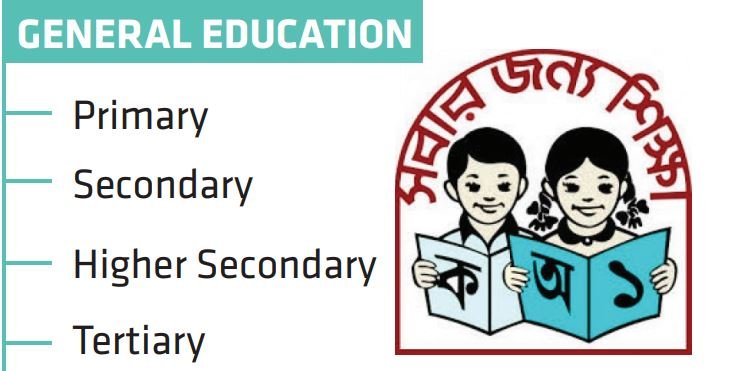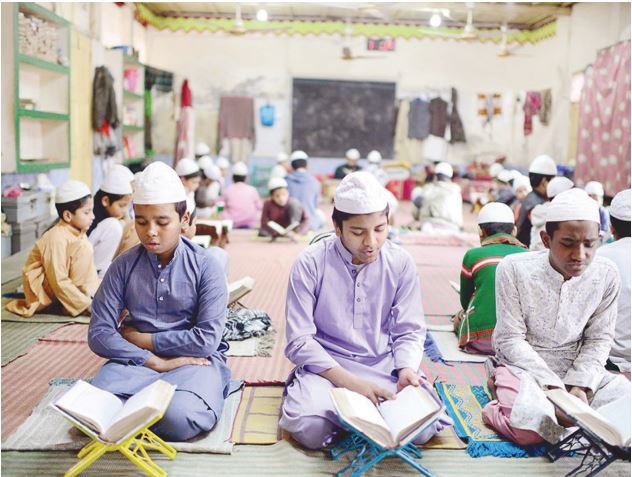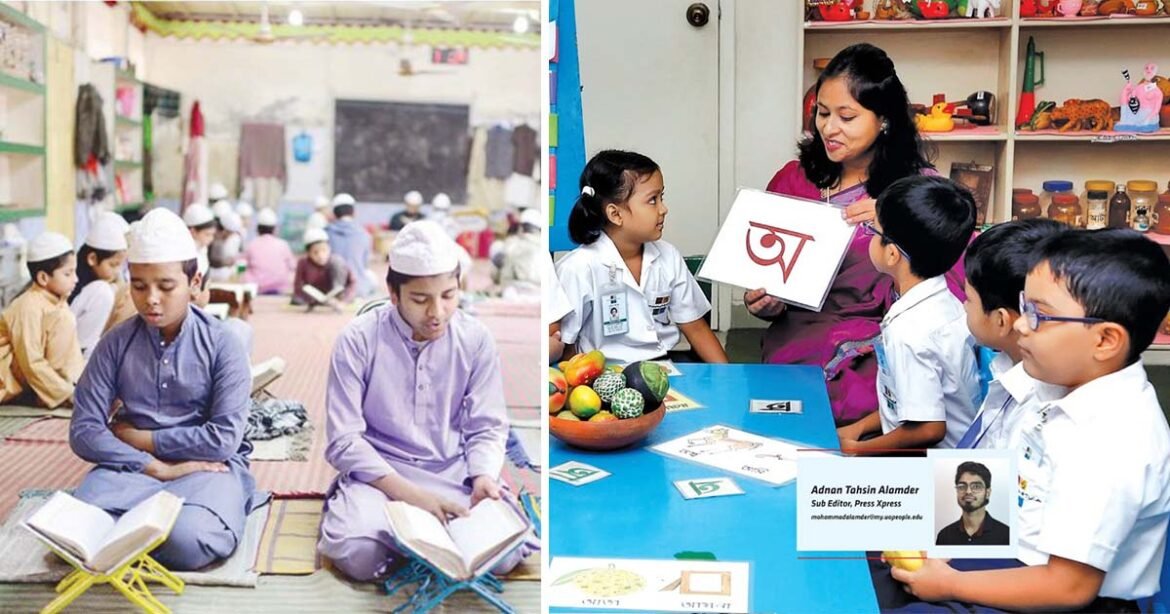Bangladesh has set its objectives for 2041, when this country aims to be counted as a developed nation. However, achieving these milestones for national development is heavily dependent on the education system of Bangladesh. Despite its crucial role, the education system in Bangladesh is marred by a major concern that often goes unaddressed: the divisive nature of the system. Three parallel streams of education, namely English medium, Bangla medium, and Madrasa education, divide the nation along social and economic lines, perpetuating disparities and hindering progress towards building a modern and prosperous nation. This article, written by ADNAN TAHSIN ALAMDER, digs deep into our education system.
You can also read: Tradition vs New values: What does the global stats say?
The divide in the education system creates a disparity in the quality of education, opportunities, and outcomes for students. A country that deals with multiple education systems often finds it tough to build a commonly structured nation in the future. Even social class also becomes a burden issue in this case. In Bangladesh, English-medium schools and madrasas cater to the elite and religiosity, respectively, while the majority of students attend Bangla-medium schools often suffer from inadequate infrastructure, teacher shortages, and out-dated curriculum. This leads to a mismatch in skills and knowledge, creating a pool of highly educated but unemployable graduates. Moreover, the education system fails to equip students with the critical thinking, problem-solving, and creative skills necessary for the 21st-century workplace.
To achieve the objectives set for 2041, it is imperative to address the divisive nature of the education system and make it more inclusive and equitable. There should be provisions for improving the quality of education in Bangla-medium schools, aligning the curriculum with industry needs, and providing teachers with adequate training and resources to teach critical thinking and problem-solving skills. Though the ideal teacher-student ratio should be 1:18, the number is much higher in case of Bangla medium schools, madrasa education (both Alia and Qawmi), and vocational education systems.
The current structure of this ununified schooling system in Bangladesh has its roots in the colonial period and has been firmly established since the beginning of this century. Among the Bangladeshi school-going students, the majority are enrolled in the mainstream school system. However, a significant minority of students attend the madrasa system, which is partly supported by the government and also has an independent stream named Qawmi. Additionally, a small, privileged section of society sends their children to English-medium proprietary schools.
Unfortunately, this system of education is causing division and discrimination within the nation as it pulls students in three different directions. The unfairness of this system is highlighted by the low quality of education offered to the majority of children. This includes students in madrasas (both Alia and Qawmi), most students in mainstream government schools, and those in government-assisted Bangla schools. Only a selected group of elite institutions such as English-medium schools, cadet colleges, and private Bangla schools seemed to offer quality education who are either better funded or received high compensation from parents.
BANGLADESH EDUCATION SYSTEM IN STATISTICS
While schools cannot solve all social divisions, good schools with a shared curriculum can help minimise them. Unfortunately, the current education system in Bangladesh is failing to do so. At the primary level, approximately 85 percent of students attend mainstream Bangla-medium schools, with the remaining students evenly divided between madrasas and private kindergartens that claim to be English-medium.

At the secondary level, two-thirds of all enrolled students are in Bangla-medium schools, with around 30 percent in Alia (government-supported) and Qawmi madrasas and only 5 percent in English schools. Furthermore, though about 95% of students aged 6–11 are admitted to primary school, not all children complete this level of education, and only around 70% of these students continue their studies in secondary school or madrasa.
HOW FARES THE BANGLA MEDIUM STUDENTS?
With a total enrolment of 85 percent students, Bangla medium schools are the most numbered institutions in Bangladesh dealing with providing education to students. According to data found in Bangladesh Education Statistics 2021, in total, there are 18,887 institutions and 89,30,245 students reading in Bangla-medium schools in Bangladesh.

Students studying in Bangla-medium institutions get some benefits compared to other formats of the education system prevailing in Bangladesh. Among its many benefits, one of the most important is its students’ easy access to public universities. Though students from other backgrounds also get chances in notable amounts in the public universities of Bangladesh, due to the similarities of the curriculum and test structures, students from Bangla-medium institutions get the most access to these universities.
In Bangladesh, students of the public universities are considered the most brilliant students. Which is why these students later get good opportunities to join in the job sectors too. Employers are used to giving these students greater priority in job placements than those from other backgrounds.
But, besides these pros, there are some cons too, which we should consider as well. Students of Bangla mediums usually find it tough to engage themselves with the changing language-based structure of different classes. When a student gets promoted from primary school to high school, he has to get introduced to his already-known topics in new, updated, and mostly English names. For this reason, many students find it difficult to adjust in short order.
Students from Bangla-medium schools have to cope with English in their university life as well, as most of the universities, public or private, in Bangladesh use English as a medium of instruction. And they also have to read and write in English, of which they are not used to, except for the English subject. If a student chooses to apply for a scholarship at foreign universities, these students have to prove their English proficiency by sitting for IELTS, GRE, GMAT etc. exams. This is a costly and time-consuming issue that must be addressed.
The GPA system of evaluating students in SSC and HSC standard national examinations is also highly controversial.
While most of the countries in the world uses a scale of 4.0 as standard, our national curriculum until higher secondary level uses a 5.0 scale. Even all the public and private universities in the country uses a 4.0 scale. But what is even more controversial is the sheer number of students that get the coveted GPA 5.0. Our social and political aspirations to project success in academic level have compromised the quality of education in this medium.
The dichotomy between English and Bangla divisions is not simply a matter of language preference but also reflects a larger class struggle and social hierarchy
Iffat Jahan faculty
University of Queensland, Australia
BRITISH CURRICULUM, CATERING TO THE ELITE
In the case of English-medium schools, there are two types of education systems in Bangladesh: English-medium schools under the British curriculum and English-version schools with the national curriculum. Though the number of schools of these two types is unknown respectively, there are a total of 137 schools that run their curriculum in English. In this case, all the subjects are taught in English except for those in Bangla. According to Bangladesh Education Statistics 2021, the total number of students studying in these schools is 26,596, and a total of 6453 teachers are assigned to provide these students education there. So, the teacher-student ratio here is 1:5, which is much lower considering the ideal of 1:18.
Unlike Bangla-medium students, English-medium students also enjoy some benefits. Among them, access to foreign universities for higher education is one. In many cases, these students do not need to sit for the proficiency tests because their medium of instruction at their native institutions is English. So, a document proving their English-background educational policy becomes well known enough for these students to get the chance to apply for scholarships and get it as well.
Moreover, the students of English-medium schools enjoy a well-structured education policy too, which is not a regular case for students from other backgrounds. This structured education policy helps the students to enjoy a higher quality education and enrich their knowledge thereby too, with other extra-curricular activities as well.
But, it is a noteworthy fact to mention that most of the students studying in these schools are from wealthy backgrounds, as these schools demand much higher payments than all other educational institutions in Bangladesh. For which, this higher payment creates a barrier for the students from the middle class or lower than that to take education from these educational institutions, which gives rise to the social divide too. Students studying in these schools often find themselves different than those studying in traditional institutions or madrasas, creating a superiority complex in them.
English is widely viewed as the language of science, technology, and globalisation, but it has also been a source of failure, frustration, and low self-confidence for many students in Bangladesh, particularly those in Bangla-medium schools, who face challenges in mastering the language
Amy B. M. Emeritus Professor,
University of Hong kong
Moreover, the two systems, the British and the national curriculum, are also vastly different from each other. Though the national curriculum is much more linked to the traditional system and the books taught there are just the English translations of those in Bangla mediums, the British curriculum is fully different in this case. The books of the British curriculum are produced by maintaining UK standards, and there remain no similarities with traditional methods in this system, which increases the educational disparities in large measure.
Students of English-medium schools and colleges also face several barriers in getting admitted into public universities too, as most of the students who get a chance here are from Bangla medium. So, coping with them and the surroundings becomes a challenge for these students. At the same time, though there remain different question patterns for students with English-medium backgrounds, the rate of success for these students is a bit lower compared to that of the Bangla-medium students.
ALIA AND QAWMI: RELIGIOUS EDUCATION FOR LOWER INCOME BRACKET
In Bangladesh, there are two types of madrasa education: the Alia and the Qawmi. Though the Alia institutions are governed under the madrasa education board of the Bangladesh government, the Qawmi educational system is governed by a totally independent body. There is no governmental regulation of these institutions, and the authorities of these institutions have the full power to run the system on their own.

The number of these Qawmi madrasas is also much higher, at 19,199, according to the education minister. This number is the highest among all other educational institutions. A body that is not regulated by the government and where there are no regulations on the syllabus that is taught there is becoming a major concern for the country in case of sparkling the fundamentalism and so-called jihadi ideals among the students.
Moreover, most of the students studying here face a lack of proper guidelines when competing with the students of other mediums. In fact, 75 percent of them remain jobless after completing their educations at these madrasas, as their system does not comply with timely needs. The teacher-student ratio here is also a burning problem, as the rate is 1:35, which is higher than the ideal one.
There are more than 70 lakh students studying in these educational institutions, and more than 2 lakh teachers are assigned there to teach education in these madrasas. On the other hand, there are 9291 Alia madrasas in Bangladesh, and only three of them are governmentally owned. But all 9291 Alia madrasas are regulated under the madrasa education board of Bangladesh. There is another body under the Alia stream, which is known as Dars E Nizami, named after the founder of this system, Nizam Ul Mulk At-Tusi, a Vijier (Prime Minister) of the Seljuq Dynasty in the 11th century. This system is entirely governed by the Alia stream, and the majority of students studying in this format also receive traditional education
SEVERAL POBLEMS IN EDUCATION SYSTEM OF BANGLADESH

TEACHER-STUDENTS RATIO
- Secondary Education: 1:38
- English Medium: 1:5
- Madrasa Education: 1:24
- Qawmi Madrasa: 1:35
- Technical-Vocational: 1:21
- Ideal ration is 1:18
TECHNICAL-VOCATIONAL EDUCATIONAL SYSTEM
The technical-vocational educational system in Bangladesh is designed to make students ready to meet the technology-based education demand of the 21st century. The students studying here are taught practical education regarding mechanisms and manual or hand-technique-based skills. There are a total of 762,108 students studying in vocational institutions in Bangladesh, and a total of 36,745 teachers are assigned there to provide teaching. The teacher-student ratio here is a little bit higher than the ideal one, as the total is 1:21. There are 2,489 regulated technical-vocational institutions in Bangladesh. The students studying in vocational and technical institutions become more skilled in technical works, compared to those from other backgrounds. These students become adroit at doing machine-related jobs in a pretty well-mannered style, which is something tough for the students of other backgrounds as it needs a handful of experience to do.
But, though vocational and technical education is crucial to meet the demands of the 4th industrial revolution, Bangladesh is still not up to the mark compared to other notable countries in the world. South Korea has provided vocational education to 96% of its workforce, which consists of 19- to 24-year-olds, in response to the need for this type of education. In the United Kingdom and Germany, the figures are 52% and 75%, respectively. But Bangladesh, on the other hand, has less than 10% of its students studying in vocational institutions. Employers usually give priority to BSC background students in providing jobs over these vocationally trained students, even though they are trained hand in hand for these jobs. Most of the job circulars mention the position only for the BA, BSC, BBA, or something like that in their advertisements, where privileges for diploma engineers get very rare opportunities. For which, after completing their diploma, these students have to go to other universities too to acquire the BSC title as well.
Another challenge is the shortage of qualified teachers and trainers. The lack of trained teachers and trainers results in lower quality education that fails to meet industry demands. According to a report, more than 80% of the fresh computer science graduates here fail to meet the organisation-needs set by the employers, which results in joblessness for these students. The lack of proper funding and infrastructure is also a significant challenge. Vocational education institutes lack the necessary infrastructure, such as modern equipment and technology, to impart quality education.
UNIFICATION OR HARNESSING STRENGTHS FROM DIVERSITY
The education system in Bangladesh needs significant reform to ensure that all children have access to high-quality education that prepares them for the 21st century. While the government introduced a new education policy in 2010, it failed to address the major structural reforms necessary to undo the entrenched three-way division in the education system.
It is not that the entire system is deem and grim. The diverse backgrounds have its own wider merits as well. Students from Bangla medium are found to be highly resourceful, adaptive and resilient in higher education or workplace. The British curriculum-based students are found to be analytical and critically thoughtful. The students from Alia or Qawmi backgrounds are very hard-working. The key is to channel and streamline each strength.
Higher education in universities and ultimately employment opportunity is the final target for any education system. There should be a codification on how to integrate or merge the different backgrounds of students into this final target. Students needs to be free to decide their career goals or even change it when they find a better interest.
This division reflects larger societal divisions, with the elite patronising private English-medium schools, the middle and lower-middle classes sending their children to government- or government-supported Bangla-medium schools, and the poor enrolling their children in Alia or Qawmi madrasas, often due to affordability and/or religious motivations. Can there be any steps by which this social deviation can be met with?


